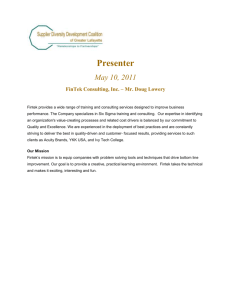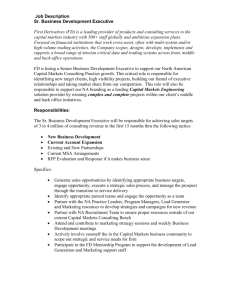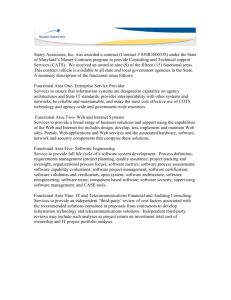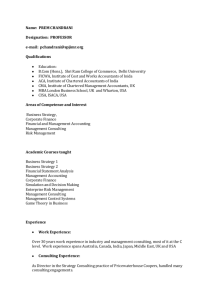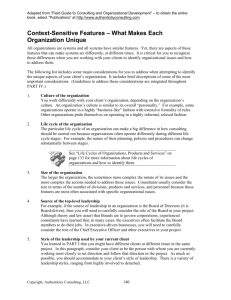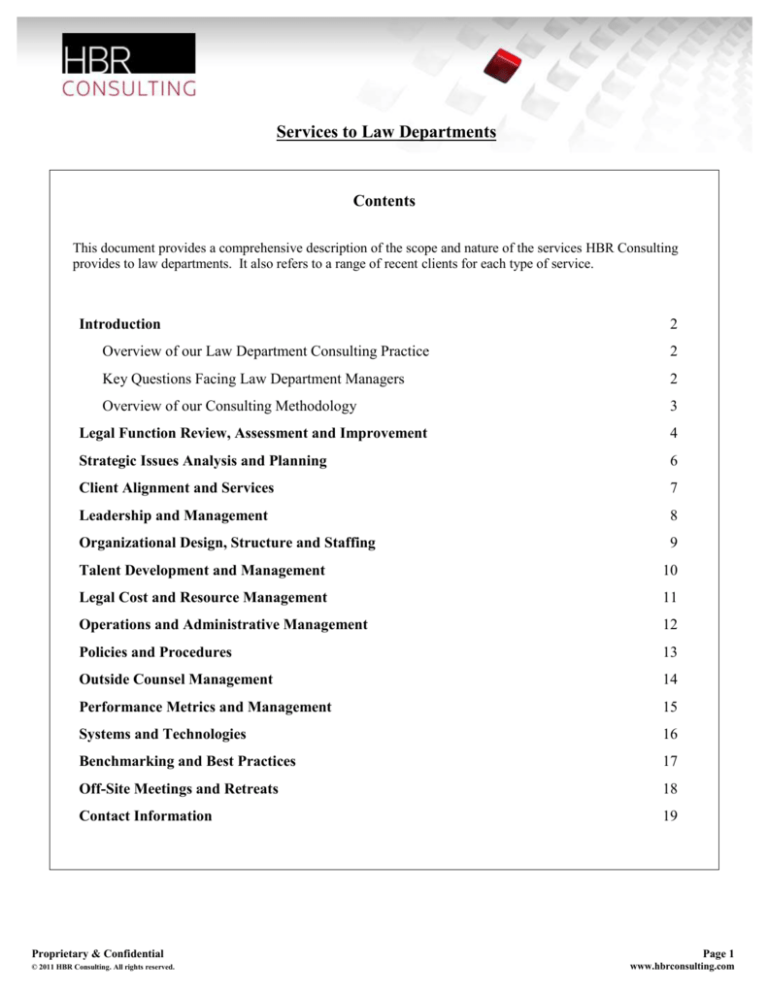
Services to Law Departments
Contents
This document provides a comprehensive description of the scope and nature of the services HBR Consulting
provides to law departments. It also refers to a range of recent clients for each type of service.
Introduction
2
Overview of our Law Department Consulting Practice
2
Key Questions Facing Law Department Managers
2
Overview of our Consulting Methodology
3
Legal Function Review, Assessment and Improvement
4
Strategic Issues Analysis and Planning
6
Client Alignment and Services
7
Leadership and Management
8
Organizational Design, Structure and Staffing
9
Talent Development and Management
10
Legal Cost and Resource Management
11
Operations and Administrative Management
12
Policies and Procedures
13
Outside Counsel Management
14
Performance Metrics and Management
15
Systems and Technologies
16
Benchmarking and Best Practices
17
Off-Site Meetings and Retreats
18
Contact Information
19
Proprietary & Confidential
© 2011 HBR Consulting. All rights reserved.
Page 1
www.hbrconsulting.com
Services to Law Departments
Introduction
Overview of our Law Department Consulting Practice
HBR Consulting (and its predecessor firms – Hildebrandt, Hildebrandt Baker Robbins) has established the
premier reputation among consultants to law departments in the United States, Europe and other parts of the
world. We have played a significant thought leadership role in law department management and technology and
have contributed to the definition of trends and best practices in this field over the past twenty five years.
Our team has completed than 700 law department consulting projects with more than 500 organizations. In the
U.S. our clients span virtually all industries in the private sector and all levels of government (Federal, state,
municipal/local, and regional) as well as not-for-profit organizations. Outside the U.S., we have unmatched
experience working with clients in the public and private sectors in Canada, the United Kingdom and Europe,
Middle East, Africa, Australia and New Zealand, and the Asia Pacific region.
We have deep legal functional experience in specific areas – e.g., compliance, legal risk management, contract
management, litigation/dispute management, intellectual property, transactional/deal work, and corporate
secretary. We offer a uniquely broad and integrated range of services to law departments - strategic, management,
work process and technology, benchmarking, and best practices.
Key Questions Facing Law Department Managers
Some of the important questions that we help our clients address include:
●
What are the current and projected needs for legal services in our organization – both overall and
individual client units – e.g. business and staff units?
●
What is our legal function’s identity and role in the organization? Do clients know it?
●
What should be our law department’s strategy and goals over the next several years?
●
What specific roles do our internal lawyers play? Are they striking the right balance between legal and
business advice? Between protecting the organization and helping to advance business goals?
●
What does our company and internal clients think of the services we provide to them?
●
Is our department giving the company the best value for money?
●
Do we strike the right balance in managing legal risks and advancing the goals of our clients?
●
How do we compare to peers in terms of legal staffing, spending and compensation?
●
Do we have an effective organization and staffing structure?
Proprietary & Confidential
© 2011 HBR Consulting. All rights reserved.
Page 2
www.hbrconsulting.com
Services to Law Departments
Key Questions Facing Law Department Managers (continued)
●
Have we optimally allocated our legal resources in the right areas, and with the right mix of inside and
outside resources?
●
Are we properly developing and compensating our lawyers?
●
Has the general counsel and management team established an effective organizational culture and
communications within the department?
●
Are we operating at top efficiency in terms of our work processes, use of support staff, and application of
systems and technologies?
●
Are we retaining the most appropriate law firms and paying them appropriately?
●
How can we define meaningful performance metrics and establish effective reporting systems?
Overview of our Consulting Methodology
Our consulting work varies in scope, complexity and duration. Some clients seek to achieve a fundamental
transformation in the organization and performance of their legal function, and this may entail a multi-project
working relationship that extends over a multi-year relationship. More typically, our consulting assignments
involve several phases of work over four to twelve months and cover a wide range of issues and improvement
areas. Finally, some projects focus more narrowly on one or a few issues and are completed in two to four
months.
Recognizing this variability, many of our law department projects, such as a comprehensive review and
assessment, would involve the following phases:
●
Project Planning and Initiation; Background Information
●
Fact-Finding Interviews and Surveys
●
Benchmarking and Best Practices
●
Summarization and Analysis
●
Brainstorming and Working Sessions
●
Report Preparation and Presentation
In our consulting projects, we typically perform most of the work. Client personnel define the project goals; help
determine the approach and workplan supply background information and data; schedule interviews; participate in
meetings and brainstorming sessions; and review and comment on our working documents and draft deliverables.
Variations occur in the extent to which clients wish to participate in or perform individual tasks. Some establish a
steering committee, group or team to direct project activities and participate closely in reviewing the progress of
the project. In some cases, we play a limited advisory or review role, and the client takes the lead in defining and
performing more of the work.
Proprietary & Confidential
© 2011 HBR Consulting. All rights reserved.
Page 3
www.hbrconsulting.com
Services to Law Departments
Legal Function Review, Assessment and Improvement
Law departments periodically engage an outside consultant to conduct a comprehensive, independent review (or
diagnostic, assessment, management audit, etc.). Such a review can be initiated by a variety of sources – e.g., the
CEO, CFO, head of HR, or other member of senior management. It may be tied to a broader company-wide
management initiative or consulting review. In these cases, the company and/or the consulting firm seeks our
deeper and more specialized expertise and knowledge of law department best practices. Most often, however, a
law department assessment project originates with the general counsel or other member of the legal leadership
team.
Our review projects for law departments typically cover many of the following areas:
●
Identity and Role of the Legal Function
●
Demand for Legal Services; Serving the Company and Clients
●
Performance Metrics and Management
●
Leadership, Management and Communications
●
Organizational Structure; Functions, Roles and Responsibilities
●
Organizational Culture and Behavior
●
Staffing; Legal Talent Development and Management
●
Financial Management; Optimizing Legal Resources
●
Policies and Procedures
●
Work Activities, Processes and Operations
●
Systems and Technologies; Knowledge Management
●
Outside Counsel Management
Proprietary & Confidential
© 2011 HBR Consulting. All rights reserved.
Page 4
www.hbrconsulting.com
Services to Law Departments
Legal Function Review, Assessment and Improvement (continued)
During these reviews, we often apply our proprietary Characteristics of a World Class Legal Function practice
aid as well as other relevant practice aids. The reviews typically lead to the development of a strategic, business
and/or operational business plan for the law department.
Recent clients:
●
Large Midwestern Utility Company
●
Leading Global Life Insurance Company
●
Leading Hospital and Health Care System
●
Global Coatings and Chemicals Company (based in Europe)
●
Global Medical Devices Manufacturer
●
Leading Entertainment & Media Company
●
Global Food & Beverage Company (based in Europe)
●
Top 3 Aerospace & Defense Company
●
Large Retail Company
●
Regional Health Care / Hospital System (non-profit)
●
Biotechnology Company
●
Large Diversified Financial Services Company
●
Preeminent Non-Profit and Research Organization
●
Second Largest School District in the U.S.
●
Law Department of a Large Canadian City
●
Universities (one in Southeast, two in Northeast, one on West Coast)
Proprietary & Confidential
© 2011 HBR Consulting. All rights reserved.
Page 5
www.hbrconsulting.com
Services to Law Departments
Strategic Issues Analysis and Planning
Recently we have conducted several projects involving a review of specific strategic issues and concerns
identified by the general counsel. These issues might concern such topics as:
●
What is the law department’s role and identity in the organization?
●
What is the role of individual in-house lawyers – e.g., advocate, counselor, confidante, cop, early warning
system for the company? How should they balance these roles? Are there differences in the selfperception of lawyers, and the perception of clients, about the role of lawyers?
●
How does the law department relate to other risk management, compliance and control functions in the
organization that are charged with preventing, identifying and reporting wrongdoing?
●
What information should be formally reported or otherwise communicated up the management chain to the
general counsel? What is the right balance between avoiding micromanagement while remaining informed
about the most important issues in the legal function?
●
What should be the specific management roles and responsibilities of various members of the legal
function management team – e.g., regional general counsel; global practice leaders?
Sometimes these projects result in a formal report or other deliverable (e.g., policies and procedures), but more
often they lead to an off-site meeting or retreat in which we present findings and facilitate discussion and
identification of changes and action items.
Recent clients:
●
Leading Entertainment & Media Company
●
Leading U.S. Health Care Services Company (non-profit)
●
Top Five Oil & Gas Company (based in Europe)
●
Global Medical Devices Manufacturer
●
Global Investment Bank
●
Two Sovereign Wealth Funds (in the Middle East)
●
Top 3 global Retail Company (based in Europe)
●
Universities (one in Southeast, two in Northeast, one on West Coast)
Proprietary & Confidential
© 2011 HBR Consulting. All rights reserved.
Page 6
www.hbrconsulting.com
Services to Law Departments
Client Alignment and Services
In-house lawyers differentiate themselves from outside law firms by their intimate knowledge of the business and
clients whom they serve. Following are key questions related to the legal function’s alignment with and services
to clients.
●
How is the law department strategy linked to the company's overall business strategy?
●
Are business needs for legal services defined, and is the law department meeting those needs?
●
How does the legal function anticipate demands for legal services in the company?
●
How well integrated are the lawyers with the business organization?
●
Do lawyers have a strong business orientation and understanding?
●
Do clients value the services of the law department, and look to inside lawyers as their primary source of
legal service and advice?
●
What are client expectations about legal services – e.g., with respect to technical competence,
responsiveness, client service style and cost?
●
Does the law department know how well it is meeting these expectations?
We help law departments identify the needs, expectations and satisfaction levels of their clients – both
organization-wide, and within individual business and functional units. More broadly, we evaluate the alignment
and integration of lawyers with clients within the organization.
Recent clients:
●
Global Coatings and Chemicals Company (based in Europe)
●
Leading Health Plan Company
●
Regional Catholic Hospital and Health System Company
●
Top Interstate Pipeline Company
●
U.S. subsidiary of a global Food & Beverage Company
●
International Financial Institution (one of the largest, based in Europe)
●
Universities (one in Southeast, two in Northeast, one on West Coast)
Proprietary & Confidential
© 2011 HBR Consulting. All rights reserved.
Page 7
www.hbrconsulting.com
Services to Law Departments
Leadership and Management
The success of a law department depends on the performance of the general counsel and other leaders and
managers in the department. Key questions include:
●
Have the roles and responsibilities of law department leaders and managers been clearly defined, both for
the group as a whole and its individual managers?
●
What information is reported and communicated in the law department, both bottom-up and top-down?
●
What impact do the leaders and managers have on the organizational culture of the department?
●
How does the department overcome the tendency towards silos and resolve conflicts?
We help clients with all aspects of law department leadership and management. Our core Law Department
Consulting Practice is complemented by our Executive Education and Talent Development Practice, which
provides services in the areas of leadership and management training, skill development, and team building.
Recent clients:
●
Mid-Sized Retail Company
●
Preeminent Non-Profit and Research Organization
●
Global Coatings and Chemicals Company (based in Europe)
●
Global Investment Bank
●
Top 5 Money Center / Commercial Bank
●
Leading Insurance Brokerage Firm
Proprietary & Confidential
© 2011 HBR Consulting. All rights reserved.
Page 8
www.hbrconsulting.com
Services to Law Departments
Organizational Design, Structure and Staffing
General counsel can consider different models for organizing and staffing their law department. Key questions
include:
●
How does the law department organization support its role and mission?
●
Is the legal function organized to maximize the effectiveness and efficiency of legal service delivery and
management?
●
Is the right balance struck between centralization and decentralization in a large, complex company and
legal function?
●
Are lawyers and support staff assigned effectively to clients and to each other?
●
Have staff roles and responsibilities been defined? Does the staff have appropriate skills for evolving
needs?
●
How might a different staffing organization configuration improve work processes or service delivery?
●
Is there adequate internal staff to meet current and anticipated client needs?
●
Do reporting relationships strike the right balance between the goal of a single, integrated legal function,
client responsiveness and business orientation?
●
How does the legal function organize and approach the management of specific legal practices areas - e.g.
transactional work; employment; corporate secretary; litigation; intellectual property; international? How
do they interface with business lawyers, and with each other?
We help clients design and structure their law departments to achieve optimal performance in the context of their
strategies and goals, and informed by current trends and best practices.
Recent clients:
●
Global Fast Moving Consumer Goods Company (based in the U.S.)
●
Top 10 Electric & Gas Company
●
Regional Health Care / Hospital System (non-profit)
●
Second Largest School District in the U.S.
●
Leading U.S. Life Insurance Company
Proprietary & Confidential
© 2011 HBR Consulting. All rights reserved.
Page 9
www.hbrconsulting.com
Services to Law Departments
Talent Development and Management
Legal talent management has become a major concern for law department leaders in recent years. Law
department managers are tasked with providing a rich and satisfying career experience to a demanding group of
legal professionals within the traditionally flat structure of a law department. Talent management is one of the
keys to the law department’s ability to perform at peak. Key questions include:
●
Does the legal function have the strategies and programs in place to hire, develop and retain the best
talent?
●
How should attorney titles and levels be employed in the law department to best advantage?
●
What are the relevant competencies and capabilities required in the law department? How can these be
defined, communicated and used effectively?
●
How can law departments define and communicate attorney career paths?
●
What types of training programs and development assignments should be considered to enhance the
capabilities of the legal staff?
●
Do we identify high potential lawyers, and if so, by what methods and criteria?
●
How effective is the current compensation program in achieving management objectives - such as
recruiting and retaining desired staff at all levels? Is it competitive with the department's market and
industry (including outside counsel)? Does it consist of the proper balance of base pay and incentive
components?
●
How does the legal function utilize other forms of recognition and reward to motivate the staff?
We help clients with all aspects of evaluating or developing a talent management program, including: skill and
competency models; career path and planning; titles and levels; performance planning and evaluation;
recruitment, retention and turnover; professional development and training; leadership and coaching; motivation
and morale; diversity; and communication about these programs to the members of the legal function.
Recent clients:
●
Large Privately-Held Diversified Financial Services Company
●
Fortune 200 Technology Services Company
●
Global Manufacturing Company
●
Global Food & Beverage Company
Proprietary & Confidential
© 2011 HBR Consulting. All rights reserved.
Page 10
www.hbrconsulting.com
Services to Law Departments
Legal Cost and Resource Management
Law department managers are under relentless pressure to reduce and manage legal costs. There is a never-ending
search for more efficient ways to work. Best practice law departments use data, risk analysis, business planning
sessions, and other methodologies to optimize the allocation of in-house legal resources to highest-value functions
and most cost effective usage.
Many of the issues in allocating legal resources are no different today than twenty years ago.
●
Do we have the right mix between specialist and commercial/generalist lawyers?
●
Are we using paralegals and support staff to the fullest extent possible?
But some issues are more recent:
●
Given the significant expansion of corporate governance, compliance and ethics in recent years, have the
roles and responsibilities of the legal function been updated to reflect these developments?
●
Has the law department explored the possibility to significantly lower legal costs through offshoring some
of its work (“legal process offshoring”)?
Drawing on over two decades of consulting experience, we have developed a practice aid on Optimizing Legal
Resources, which is devoted to helping law departments answer this fundamental question, posed by one of our
general counsel clients a few years ago: “Do we have the right number of people, in the right areas, doing the
right things?” We work with clients to collect the data and perform the analysis necessary to identify immediate
opportunities for cost reduction or efficiency. We also transfer the knowledge and skills in this methodology so
that our clients can be self-sustaining in continuing to update the analysis.
Recent clients:
●
Top 5 Global Pharmaceutical Company based in Europe
●
Leading Entertainment & Media Company
●
Leading Global Life Insurance Company
Proprietary & Confidential
© 2011 HBR Consulting. All rights reserved.
Page 11
www.hbrconsulting.com
Services to Law Departments
Operations and Administrative Management
In-house lawyers should be surrounded by efficient work processes and an effective support staff (typically
paralegals, legal assistants, executive assistants, secretaries). Larger law departments often have professional nonlawyer managers and even an operations or business management unit to help the general counsel administer the
department.
How smoothly does your law department run from a business operations and administrative standpoint? Are
lawyers and support staff assigned effectively to clients and to each other? Have staff roles and responsibilities
been defined? Does the staff have appropriate skills for evolving needs? How does staffing - in aggregate and by
ratio - compare to similarly situated companies? Does the department make adequate use of legal assistants and
other non-lawyer staff? How effectively do lawyers work with secretaries and other staff in the department? Is
the physical layout conducive to communications and comfortable workspace? Does the filing system encourage
work product sharing?
HBR Consulting understands the management techniques and best practices to improve the operation of your law
department. We help clients review the organization of their business operations and administrative staff (e.g.,
paralegals, secretaries, other operations and support staff); adequacy of administrative staffing levels; staffing
assignments, workflow and supervision; organization and management of the business operations and
administrative group; training, development and evaluation of administrative staff; and communications,
teamwork, morale and cultural issues.
Recent clients:
●
Leading Global Life Insurance Company
●
Leading National Transportation Company
●
Large Diversified Financial Services Company
●
Top 10 Electric & Gas Company
Proprietary & Confidential
© 2011 HBR Consulting. All rights reserved.
Page 12
www.hbrconsulting.com
Services to Law Departments
Policies and Procedures
Organizations establish policies and procedures to govern how it handles and manages issues and activities
involving legal risks, expertise, advice and services. Some policies and procedures are established and
communicated at an organization-wide level. Other more detailed policies and procedures – often in the form of a
law department operations manual - are developed solely for use by the internal law department staff.
Has the legal function established clearly defined and documented policies and procedures to govern its
operations? Has it established an organization-wide statement of policies on legal issues and services? Does the
law department have an internal procedures manual for lawyers and staff?
We can help your law department develop and document policies and procedures in alignment with your overall
strategy.
Recent clients:
●
Global Coatings and Chemicals Company (based in Europe)
●
Top 3 Global Retail Company (based in Europe)
●
A Sovereign Wealth Fund (one of the world’s largest)
●
Government Agency (based in the Middle East)
Proprietary & Confidential
© 2011 HBR Consulting. All rights reserved.
Page 13
www.hbrconsulting.com
Services to Law Departments
Outside Counsel Management
HBR Consulting understands quality and cost are the two most important aspects of selecting outside counsel. We
also know low hourly rates do not necessarily equate to lower total costs.
How do you know if your law department retains the right law firms on the right terms? Does the company have
the optimal mix of inside and outside resources? Has the department established policies and procedures for
working with outside counsel? Are these real or paper programs? What results have been achieved? Has it
developed effective relationships with primary counsel? Are effective technology links established with outside
counsel? Does the outside counsel strategy reflect current economic realities?
We help clients assess or develop their strategies, policies, programs and procedures for managing outside counsel
services, costs and relationships. We draw upon a range of resources in performing this work, including our two
decades of consulting experience in this area; identification of current and best practices in outside counsel
management, and relevant metrics and information from our annual benchmarking survey, the HBR Law
Department Survey. In addition, we have developed a practice aid on Best Practices in Outside Counsel
Management. This analytic framework helps us efficiently review and assess a law department’s outside counsel
management strategies, programs and practices against relevant best practices.
Recent clients:
●
Leading Global Life Insurance Company
●
Large West Coast Health Care System
●
Top 3 Engineering, Design and Construction Firm
●
Biotechnology Company
●
Mid-Sized Retail Company
●
Global Chemical Company (based in Europe)
●
Top 3 Global Aerospace & Defense Company
●
Leading U.S. Government-Sponsored Corporation
●
A U.S. State Government (one of the largest)
●
Leading Global Life Insurance Company
Proprietary & Confidential
© 2011 HBR Consulting. All rights reserved.
Page 14
www.hbrconsulting.com
Services to Law Departments
Performance Metrics and Management
One of the most challenging aspects of law department management is trying to define measures of its
performance. What are meaningful performance metrics or measures of performance? How can they be used to
plan, monitor, evaluate and communicate the performance of the legal function? As a function that is concerned
with preventing problems and minimizing risks, how can the contribution of the law department be fairly
measured? How much weight should be given to quantifiable versus qualitative elements?
We help clients design, develop and implement performance metrics and management programs. In some cases,
we have been asked to focus on the front-end identification of meaningful and relevant performance metrics. In
other cases, we have helped clients address the practical application of metrics, operational issues of data
collection and reporting, and implementation planning.
Recent clients:
●
Top 10 Electric & Gas Utility
●
Leading Global Money Center Bank (based in Europe)
●
Second Largest School District in the U.S.
●
Fortune 100 Diversified Financial Services Company
●
Large U.S. Chemicals Company
Proprietary & Confidential
© 2011 HBR Consulting. All rights reserved.
Page 15
www.hbrconsulting.com
Services to Law Departments
Systems and Technologies
Law departments need systems and technologies to operate efficiently, manage their costs and activities, and
enable knowledge sharing and collaboration. Typical applications found in law departments (especially larger
ones) include: document management, matter management, electronic billing (to manage outside counsel
invoices), file & records management, and legal intranets. Practice specific applications are available in such
areas as the corporate secretary, litigation, intellectual property, compliance and ethics, and contract management.
We provide comprehensive technology services and solutions to our clients. These range from technology
assessment and planning, to requirements definition, system selection and implementation. This enables us to
provide our clients with the best strategic and management consulting combined with the best technology
consulting for law departments.
Recent clients:
●
Large Diversified Financial Services Company
●
International Financial Institution (one of the largest, based in Europe)
●
Leading Global Money Center Bank (based in Europe)
●
A U.S. State Government (one of the largest)
●
Fortune 50 Manufacturing Company
●
Global Telecommunications/Wireless Company
●
Fortune 500 Manufacturing Automation Company
●
Fortune 10 Commercial / Money Center Bank
●
Top 5 Global Pharmaceutical Company (based in Europe)
●
International Financial Institution (one of the largest, based in the U.S.)
●
Leading Global Life Insurance Company
Proprietary & Confidential
© 2011 HBR Consulting. All rights reserved.
Page 16
www.hbrconsulting.com
Services to Law Departments
Benchmarking and Best Practices
“Benchmarking” and “best practices” are terms that can have different meanings, but generally refer to the
collection and consideration of external data and information and comparing it to your own situation, as one basis
for evaluating your performance. Benchmarking tends to focus on quantitative data, while best practices analyses
typically are more descriptive and qualitative.
For the past twenty years, one of the leading benchmarking tools for law departments has been the annual HBR
Law Department Survey (formerly, Hildebrandt Law Department Survey) and its predecessor survey at
PricewaterhouseCoopers. The annual HBR Law Department Survey is the premier source of benchmarking
providing the most comprehensive statistical information on legal spending, staffing, management and
compensation. Our consistent participant profile of leading global and Fortune 500-level companies and leading
law departments distinguishes the HBR Survey from others. Our survey database enables us to provide clients
with comparative benchmarking analysis quickly and at a modest cost.
We also provide customized benchmarking and best practices services to assess a law department's practices,
procedures, spending, staffing and other performance indicators relative to the benchmark standards and best
practices of peer companies.
More broadly, we have developed “Best Practices in Law Department Management” practice aids on over two
dozen topics. We apply these tools, as appropriate, in our consulting work.
Recent clients:
●
Benchmarking Study for Large Global Pharmaceutical Companies
●
Two of the Top 5 Global Energy Companies (both based in Europe)
●
Fortune 75 Insurance and Asset Management Company
●
Fortune 100 Multi-Line Insurance Company
●
European Pharmaceuticals Company
●
Global Biotechnology & Pharmaceutical Company based in Europe
●
Fortune 50 Money Center / Commercial Bank
Proprietary & Confidential
© 2011 HBR Consulting. All rights reserved.
Page 17
www.hbrconsulting.com
Services to Law Departments
Off-Site Meetings and Retreats
HBR Consulting can participate in, or help you organize and facilitate, your law department's off-site meeting,
whether it be for strategic planning, team building, leadership training or to address a topic of specific interest to
your law department. Law department retreats often involve all staff (lawyers and support), although some offsite meetings may just involve a portion of the law department, such as the leadership team, to focus on specific
strategic or sensitive issues.
Normally our involvement in a law department off-site meeting or retreat is related to a broader consulting
project. Such meetings provide a valuable means of educating and communicating with the law department staff.
It also enables them to participate in and contribute to the decision making process.
Recent clients:
●
Top 5 Global Investment Bank (headquartered in Europe)
●
Top 5 Money Center / Commercial Bank
●
Top 10 Electric & Gas Utility
●
Large Global Food & Beverage Company (based in the United Kingdom)
●
Financial Technology Services Company
●
International Financial Institution (one of the largest, based in Europe)
●
Leading Global Life Insurance Company
Proprietary & Confidential
© 2011 HBR Consulting. All rights reserved.
Page 18
www.hbrconsulting.com
Services to Law Departments
Contact Information
To learn more about how our Law Department Consulting Group can help you, please contact us:
Jonathan Bellis
Chair, Law Department Consulting
jbellis@hbrconsulting.com
+1 (203) 470-5077
Lauren Chung
Senior Director, Law Department Consulting
lchung@hbrconsulting.com
+1 (732) 463-9342
Rebecca Thorkildsen
Senior Director, Law Department Consulting
rthorkildsen@hbrconsulting.com
+1 (312) 425-4479
Proprietary & Confidential
© 2011 HBR Consulting. All rights reserved.
Page 19
www.hbrconsulting.com

